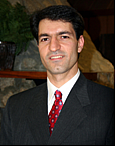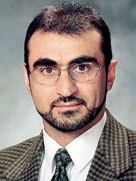|
|
|
|
|
|
Keynote Speakers

|
|
|
|
|
Dr. Nader Jalili, Associate Professor and Director of Piezoactive Systems
Laboratory Department of Mechanical and Industrial Engineering, Northeastern University, Boston, MA
Phone: (617) 373-3629,
Email: n.jalili@neu.edu,
Webpage: http://www.coe.neu.edu/psl
Dr. Nader Jalili joined the faculty of NortheasternUniversity in September 2009 from
ClemsonUniversity
(Clemson, South Carolina) where he was a tenured Associate Professor since 2000. Dr. Jalili is
currently
the Director of Northeastern University Piezoactive Systems Laboratory, and Associate Editor of
ASME
Journal of Dynamic Systems, Measurement and Control. He was the founding Chair of ASME Dynamic
Systems
and Control Division (DSCD) Technical Committee on Vibration and Control of Smart Structures.
As a past
Technical Editor of IEEE/ASME Transactions on Mechatronics, he is the author/co-author of more
than 300
peer-refereed technical publications including over 100 journal papers. He has received many
national
and international awards including the 2003 National Science Foundation CAREER Award, 2002
Ralph E. Powe
Junior Faculty Enhancement Award from Department of Energy, 2011 Mechanical Engineering (ME)
Professor
of the Year Award for Best Teaching Performance among ME Faculty Members at Northeastern
University,
2009 Clemson University McQueen Quattlebaum Faculty Achievement Award for exemplary leadership
in the
engineering profession, 2008 Murray Stokley Award for excellence in teaching, 2007
Collaboration Award
for demonstrated exemplary and synergetic collaboration in research, 2007 Clemson University
Outstanding
Young Investigator of the Year, 2007 Clemson University Graduate Student Government Award as
well as
2007 Eugene H. Bishop Award for excellence in teaching, and 2007 Ken Roby Advising Award for
excellence
in undergraduate advising. His research interests are in piezoelectric-based actuators and
sensors,
dynamic modeling and vibration control of distributed-parameters systems, dynamics and control
of
microelectromechanical and nanoelectromechanical sensors and actuators, and control and
manipulation at
the nanoscale.
Selected Related Book:
• Jalili, N., Piezoelectric-based Vibration Control: From Macro to Micro/Nano Scale Systems,
Springer,
New York, NY (2010). ISBN 978-1-4419-0069-2; 1st Ed, 517 pp. with 293 figures.
http://www.springer.com/engineering/robotics/book/978-1-4419-0069-2.
|
 |
|
A Unified Approach to Piezoelectric-based Vibration Control: From Macro to Micro/Nano Scale
Systems
This keynote talk highlights recent advances in piezoelectric materials and structures used in
a variety of vibration-control systems. The talk is divided into two interconnected parts. The
first part of the talk presents the fundamentals of piezoelectric-based systems with an
emphasis to their constitutive modeling as well as vibration absorption and control techniques
using piezoelectric actuators and sensors. More specifically, a comprehensive treatment for
both lumped-parameters and distributed-parameters representations is briefly reviewed. The
treatment offered here follows a unified approach in which an energy-based modeling framework
is adopted to describe the system behavior in an easy-to-follow manner. The materials presented
here shall form the basis for the subsequent modeling and control developments for both
piezoelectric-based systems as well as vibration-control systems. Benefiting from these
background reviews, this part of the talk covers both active vibration absorption as well as
vibration control using piezoelectric materials for a variety of systems. Starting with an
elementary level in fundamentals of piezoelectricity, this part transitions into constitutive
models of piezoelectric materials, their hysteresis and other nonlinear characteristics, and
finally their engineering applications with an emphasis to piezoelectric-based actuators and
sensors. A brief, but self-contained discussion for dealing with hysteresis and its
compensation techniques is also given. Building based on the first part of the talk, the second
part provides advances in piezoelectric-based micro/nano actuators and sensors with
applications ranging from molecular manufacturing and precision mechatronics to molecular
recognition and functional nanostructures. More specifically, applications in single-axis
nano-positioning actuators to 3D positioning piezoactive actuators are reviewed. Moreover,
scanning probe based microscopy and imaging as well as piezoelectric-based nanomechanical
cantilever (NMC) sensors and actuators with their application in many NMC-based imaging and
manipulation systems such as atomic force microscopy (AFM) and its varieties are reviewed. Both
linear and nonlinear models of piezoelectric NMC sensors and actuators are provided with their
application in biological and ultrasmall mass sensing and detection. A relatively general
comparison between modeling limitations for piezoelectric-based actuators and sensors at
macroscale and microscale is also provided. As a future pathway towards development of
next-generation sensors and actuators comprised of nanomaterials, piezoelectric nanocomposites
with tunable properties are also briefly introduced and discussed.
|
|
|
Dr. Seyed Mohammad Hashemi, Professor, Department of Aerospace Engineering, Ryerson
University, Toronto (ON), Canada, Email:smhashem@ryerson.ca, Webpage:
http://www.ryerson.ca/aerospace/research/Research%20profiles/hashemi.html
Dr. Seyed M. Hashemi is a Professor at Ryerson University, Department of Aerospace Engineering.
His research revolves around developing novel analytical, semi-analytical and numerical models
and mesh-reduction techniques in order to achieve higher convergence rates in the dynamic
analysis of intact and defective, flexible, composite/sandwich structural elements.
Dr. Hashemi has a Bachelor of Science in Mechanical Engineering from Sharif University of
Technology (SUT), Tehran/Iran (1990), and a Diplôme D’Études Profondis (DEA) en Mécanique from
the Université de Lille I, Flandre Androit, Lille (1992), France. He received his Doctor of
Philosophy in 1998 from Laval University, studying numerical modelling of blades and rotating
beam-structures in Professor Marc J. Richard Group. In particular, this work focused on
developing a highly convergent Dynamic Finite Element (DFE) method, with applications to the
vibration analysis of rotary blades and beam-structures.
Later, he worked as a research associate in the Department of Mechanical Eng., Laval
University, and subsequently joined the Professor M.F. Golnaraghi’s Group of the University of
Waterloo, where he worked on a variety of topics related to structural vibration
analysis/modelling/control, including vibration control of a turbo-Prop engine, tall buildings,
… . Dr. Hashemi also collaborated with late Prof Aftab Patla at the Kinesiology Department of
the University of Waterloo on several projects, namely passive/active vibration control of
Parkinson tremors.
Dr. Hashemi joined Ryerson University in September 2001, where he continues his research work
on Finite Elements, DFE and other numerical methods in structural vibration, design, analysis
and modelling. To date, he has (co-)authored over hundred publications, including some thirty
journal papers, nine chapters in books and edited volumes, and over seventy conference papers
on DFE applications in the areas of structural dynamics, vibration, composites/sandwich
structures, and the modeling of MEMS devices.
Dr. Hashemi is also an Adjunct Professor at the Department of Mechanical and Mechatronics Eng.,
University of Waterloo, Waterloo (ON), Canada, a licensed Professional Engineer (P.Eng.) in
Ontario, Canada, and a senior member of American Institute of Aeronautics and Astronautics
(AIAA).
|
 |
|
Development of the Dynamic Finite Element (DFE) and its Applications to Structural
Vibrations
The development of a fast convergent, frequency-dependent, Dynamic Finite Element (DFE)
formulation and its application to uncoupled/coupled vibration analysis of structural elements
is presented. The proposed method is a fusion of the Galerkin weighted residual formulation and
the ‘exact’ Dynamic Stiffness Matrix (DSM) method, where the basis functions of approximation
space are assumed to be the closed form solutions of the differential equations governing
uncoupled vibrations of the system. The use of resulting (dynamic) trigonometric interpolation
(shape) functions leads to a frequency dependent stiffness matrix, representing both mass and
stiffness properties of the element. Assembly of the element matrices and the application of
the boundary conditions then leads to a frequency dependent nonlinear eigenproblem. A
Wittrick-Williams algorithm, based on a Sturm sequence root counting technique, is then used to
extract the system natural frequencies and modes
The DFE formulation was originally applied to the free vibration analysis of rotating (i.e.,
centrifugally stiffened) beams. Incorporating different accelerations, due to the presence of
gyroscopic, or Coriolis forces, has been possible considering the fact that the resulting
stiffness matrix, in this case, is Hermitian. It has been demonstrated that the DFE can be
advantageously used when the multiple and/or higher modes of vibrations have to be evaluated.
The DFE formulation was then applied to the free vibration analysis of (geometrically) coupled
bending-torsion beam-structures, without and with warping, and was later further extended to
triply coupled bending-bending-torsion vibration of centrifugally stiffened, nonuniform beams
and blades. The effects of variable geometric parameters were taken into account by introducing
the so-called ‘deviator terms”, leading to a Refined formulation (RDFE), which results in very
high convergence rates; it can be justifiably called a ”Mesh Reduction Method (MRM)”.
Coupled extension-torsion vibration analysis of such structural elements as helical springs,
braided/twisted wire ropes and cables were also investigated. The same procedure is equally
applicable to the dynamic analysis of flexible, Circumferentially Uniform Stiffness (CUS),
laminated composite box beams and tubes, exhibiting materially coupled extension-torsion
behavior.
The bending-extension vibration of both straight and curved symmetric / asymmetric sandwich
beams has also been investigated, where the face layers follow the Rayleigh beam assumptions,
while the core is governed by Timoshenko beam theory. The DFE natural frequency results (the
1st four modes) for an asymmetric soft-core sandwich beam have shown the exact match between
the DFE and ‘exact’ Dynamic Stiffness Matrix (DSM), using only a one-element mesh; a
Quasi-Exact (QE-DFE) method.
The DFE has also been applied to the vibration and aeroelastic analysis of intact and defective
laminated composite wing configurations, exhibiting both material and geometric bending-torsion
couplings. Further research work is presently underway to include the delamination defects in
the sandwich / composite models and the preliminary results are promising. In all case studies,
the comparison between the DFE, exact DSM and FEM results, and those available in literature
has validated the proposed formulation and confirmed its practical applicability and general
superiority over the conventional FEM.
|
|
|
|
|
